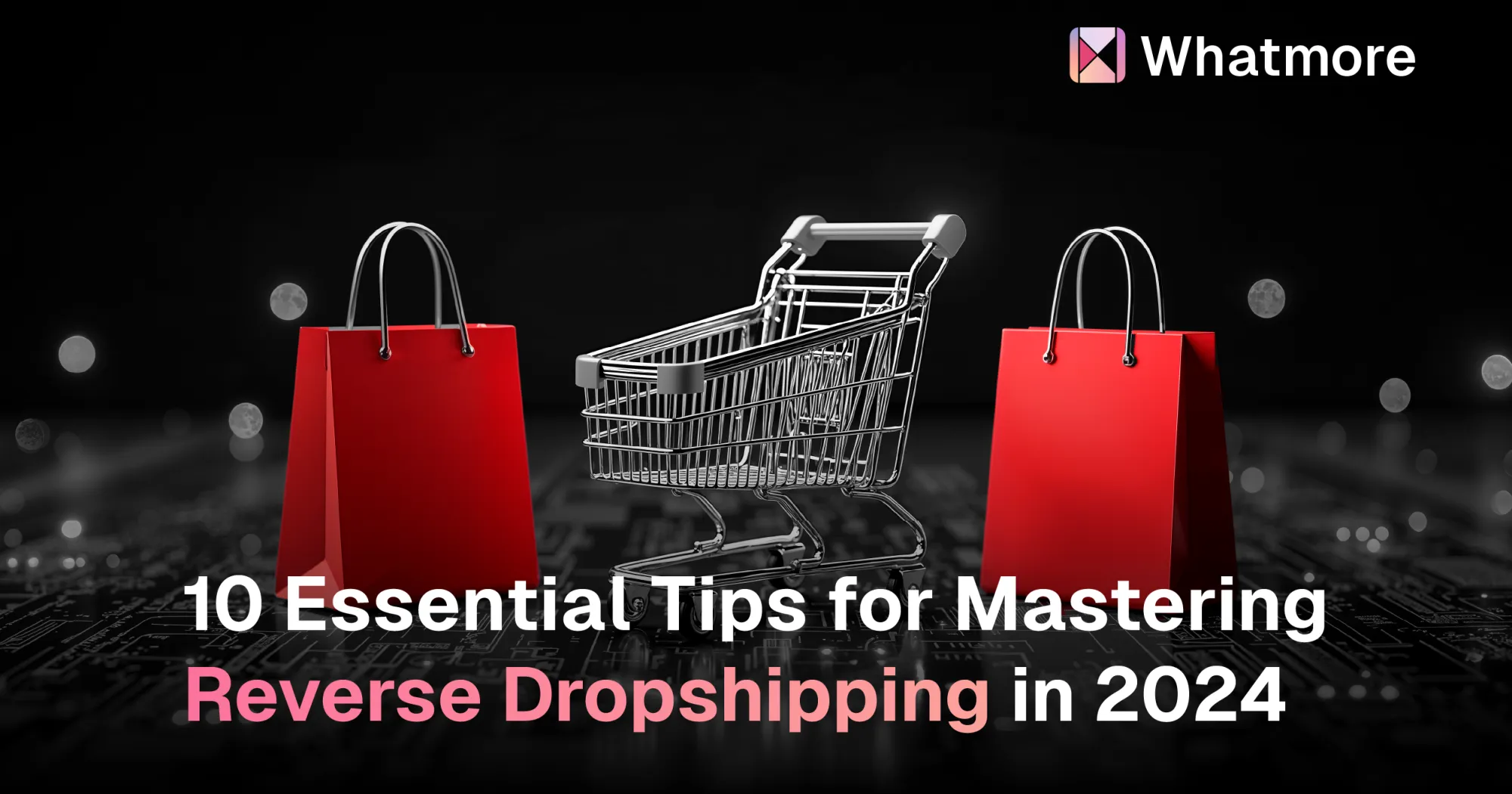Reverse dropshipping is reshaping the e-commerce landscape in 2024, offering a novel approach to sourcing and selling premium products. This business model involves acquiring high-quality goods from developed countries and introducing them to markets where these items are scarce or unavailable. As global consumers increasingly seek these exclusive products, reverse dropshipping presents a unique opportunity for entrepreneurs to tap into unmet demand.
In this article, you'll discover a comprehensive step-by-step guide on how to start a reverse dropshipping business successfully.
Understanding Reverse Dropshipping
The reverse dropshipping business model involves sourcing high-quality products from developed markets and selling them in emerging economies. Unlike traditional dropshipping, where goods are often sourced from low-cost regions to sell in more affluent markets, reverse dropshipping capitalizes on the scarcity of premium products in certain regions.
Key Differences:
- Product Source: Traditional dropshipping focuses on low-cost production areas. Reverse dropshipping sources from countries like the USA, UK, and Canada.
- Market Focus: Traditional models cater to developed economies. Reverse dropshipping targets emerging markets where demand for exclusive products is high.
Pros and Cons:
Targeting Developed Countries:
- Pros: Access to robust logistics and reliable payment systems; higher consumer spending power.
- Cons: Intense competition and saturated markets may limit growth potential.
Focusing on Emerging Economies:
- Pros: Less competition, ability to offer unique products not readily available; potential for higher profit margins due to exclusivity.
- Cons: Challenges with logistics, cultural differences, and fluctuating currency exchange rates can complicate operations.
Understanding these dynamics is crucial for anyone looking to excel in reverse dropshipping.
Step 1: Conducting Market Research
A successful reverse dropshipping venture begins with thorough market research. Understanding what consumers in different regions desire is crucial for identifying profitable niches. This involves diving deep into cultural preferences and buying behaviors, which can vary significantly across countries.
Identify Profitable Niches
Utilize tools like Google Trends or social media analytics to gauge interest in specific products. Look for gaps in the market where demand exists but supply is limited.
Understand Cultural Differences
Each target country has unique cultural nuances that influence purchasing decisions. For instance, luxury skincare items might be highly sought after in one region, while advanced electronics could be more popular elsewhere.
Analyze Buying Behaviors
Study consumer habits through surveys or consumer reports. Identify key factors that drive purchases—such as quality, brand reputation, or pricing—and tailor your product offerings accordingly.
By investing time in comprehensive market research, you position yourself to cater effectively to your target audience’s needs, ensuring higher chances of success in reverse dropshipping.
Step 2: Selecting Reliable Suppliers from Developed Countries
Choosing the right suppliers is crucial for success in reverse dropshipping. Suppliers play a pivotal role in ensuring that you offer high-quality products for dropshipping while maintaining efficient shipping times. Here are some criteria to consider:
1. Product Quality
Prioritize suppliers known for their high standards in manufacturing and product quality. Look for certifications or reviews that reflect their commitment to excellence.
2. Shipping Efficiency
Fast shipping is a key competitive edge. Ensure your suppliers can deliver products promptly, with reliable tracking and minimal delays.
3. Communication
Effective communication is essential. Choose suppliers who are responsive and willing to collaborate on resolving issues promptly.
To ensure suppliers meet your quality standards, implement these best practices:
Sample Testing: Request samples to evaluate product quality firsthand before committing to bulk orders.
Supplier Reviews: Research feedback from other businesses that have worked with them. Platforms like Alibaba or Trade Assurance can provide insights into supplier reliability.
Contracts: Establish clear agreements detailing expectations, including product quality, delivery timelines, and return policies.
Step 3: Setting Up Your Online Store on Shopify
Using Shopify as your e-commerce platform for reverse dropshipping offers numerous advantages. Its user-friendly interface allows you to set up and manage your store efficiently, even if you're new to e-commerce. Shopify provides robust tools for inventory management, order processing, and customer interactions, making it an ideal choice for handling the complexities of reverse dropshipping.
To enhance user experience on your Shopify store, consider these essential features:
- Responsive Design: Ensure your store is mobile-friendly to cater to customers browsing on different devices.
- High-Quality Product Images: Use crisp and clear images that showcase the premium quality of your products.
- SEO Optimization: Implement SEO best practices by using relevant keywords in product descriptions, titles, and meta tags.
- Secure Payment Options: Offer multiple secure payment gateways to build trust with potential buyers.
- Customer Reviews and Testimonials: Feature customer feedback prominently to establish credibility and encourage purchases.
These functionalities not only improve the shopping experience but also help in building a trustworthy brand image.
Step 4: Optimizing Product Listings for Maximum Visibility and Sales
Effective product listing optimization is essential for attracting customers and increasing sales. By focusing on SEO keywords and engaging content, you can enhance your store's visibility in search engines.
Strategies for Compelling Product Descriptions:
- Focus on Benefits: Highlight how the product solves a problem or fulfills a need. Use clear, concise language to communicate value.
- Incorporate SEO Keywords: Identify relevant keywords that potential customers might use when searching for your products. Include these naturally within your descriptions to improve search rankings.
- Tell a Story: Craft product narratives that resonate with your audience. Share the story behind the product or its unique selling points to create an emotional connection.
Importance of High-Quality Images:
- Visual Appeal: High-resolution images help convey the quality and details of a product, making them more enticing to potential buyers.
- Multiple Angles: Provide various perspectives to give customers a comprehensive view. Include close-ups of important features to enhance understanding.
- Consistency: Maintain a consistent style across all images to strengthen brand identity and professional appearance.
By integrating these strategies, you lay the groundwork for successful product listings that captivate audiences and drive sales.
Step 5: Navigating Shipping and Logistics Challenges in Reverse Dropshipping
Navigating the logistics complexities inherent in reverse dropshipping requires a nuanced understanding of international shipping hurdles. Customs delays and tariffs are common obstacles that can disrupt your operations, impacting delivery times and customer satisfaction. To mitigate these challenges, it's essential to develop a robust logistics plan.
Key Strategies:
- Research Customs Regulations: Familiarize yourself with the customs policies of your target markets to anticipate potential delays and additional costs.
- Partner with Reliable Couriers: Collaborate with established courier services known for handling international shipments efficiently. This helps ensure that packages are delivered on time, even across borders.
- Implement Tracking Systems: Use advanced tracking technologies to monitor shipments in real-time, providing transparency for both you and your customers.
- Optimize Packaging: Ensure products are packaged securely to withstand long transit periods, reducing the risk of damage during shipping.
By addressing these logistics challenges proactively, you create a seamless experience for your customers, paving the way for successful reverse dropshipping ventures.
Step 6: Implementing Effective Marketing Strategies to Drive Traffic and Sales
Effective marketing strategies are crucial for driving traffic and sales in your reverse dropshipping business. Leveraging key marketing channels can significantly boost your reach:
1. Social Media Advertising
Platforms like Facebook, Instagram, and TikTok offer targeted advertising options that allow you to reach specific demographics who are likely to be interested in your premium products.
2. Influencer Collaborations
Partnering with influencers who resonate with your target audience can enhance credibility and expand your brand's visibility. Influencers often have a loyal following, which can lead to higher engagement rates.
Building trust with potential customers is equally important. Transparent communication about product quality, shipping times, and return policies helps establish reliability. Providing excellent customer service is essential; prompt responses to inquiries and resolving issues efficiently can encourage repeat purchases and positive reviews.
Emphasizing these strategies not only attracts more visitors to your site but also increases the likelihood of conversions by fostering a trustworthy relationship between you and your consumers.
Step 7: Use Instagram & TikTok to Market Products with Short Videos
Social media platforms like Instagram and TikTok have changed how businesses connect with their audience. Short video content, such as Instagram Reels and TikTok videos, is crucial for reaching more people organically. The algorithms on these platforms love this format, which means creative and interesting videos are more likely to be shown to a bigger audience.
Why Short Videos Matter
Short videos are important because they grab attention quickly and are more likely to be shared. This is especially true on mobile devices where people have shorter attention spans. By using Instagram Reels and TikTok videos in your marketing strategy, you can increase your chances of going viral and reaching a wider audience.
How to Create Effective Short Videos
Here are some tips for creating effective short videos:
- Tell a Story: Use storytelling techniques to make your videos more engaging. Show how your product solves a problem or improves someone's life.
- Be Authentic: People appreciate authenticity. Show behind-the-scenes footage or share customer testimonials to build trust.
- Keep it Concise: Remember that these platforms favor shorter videos. Get straight to the point and deliver your message quickly.
- Use Eye-Catching Visuals: Invest in good lighting, props, and editing techniques to make your videos visually appealing.
Tools for Creating User-Generated Content (UGC)
Consider using AI-driven tools like Whatmore to create user-generated content (UGC) without spending too much money. Whatmore can help you produce authentic and diverse video content that resonates with potential customers. By featuring your products in compelling short videos, you enhance the storytelling aspect of your brand, making it more relatable and memorable.
Key Benefits:
- Increased Engagement: Short videos capture attention quickly, leading to higher engagement rates compared to static posts.
- Cost-Effective Strategy: Utilizing AI platforms reduces production costs while maintaining quality.
- Stronger Brand Presence: Regular updates with fresh video content keep your brand at the forefront of consumers' minds.
Incorporate these tools into your marketing strategy to effectively reach new audiences and drive sales in your reverse dropshipping business.
Identifying Challenges in Reverse Dropshipping
Navigating the landscape of reverse dropshipping presents unique challenges.
1. Intense Competition
Intense competition is a significant hurdle, as more entrepreneurs recognize the high profit margins and enter the market. To stand out, focus on niche products and exceptional customer service.
2. Fluctuating Currency Exchange Rates
Fluctuating currency exchange rates add another layer of complexity. These fluctuations can impact profit margins unpredictably. Utilizing financial tools for real-time currency tracking and hedging strategies can mitigate these risks.
Strategies to overcome these obstacles include:
- Market Differentiation: Offer exclusive products not readily available locally; this can create a competitive edge.
- Currency Management: Employ financial services or apps that provide favorable exchange rates and lock prices when advantageous.
- Continuous Learning: Stay updated with industry trends and consumer preferences through forums, webinars, and e-commerce communities.
Staying agile and informed helps maintain your position in this dynamic market.
The Future Outlook of Reverse Dropshipping as a Business Model
Reverse dropshipping presents compelling opportunities in the e-commerce landscape. Mastering this model offers long-term advantages:
- Higher Profit Margins: By sourcing exclusive products from developed countries, you can command premium prices in markets where these items are scarce.
- Access to Exclusive Products: This business model allows you to offer unique and high-quality goods, differentiating your store from competitors who rely on low-cost, mass-produced items.
Aspiring entrepreneurs should seriously consider venturing into reverse dropshipping. Despite its challenges, this approach caters to a niche market that values quality over quantity. With e-commerce evolving rapidly, the benefits of reverse dropshipping future outlook are promising for those ready to innovate and adapt.
Want to create videos for your dropshipping store in a minute? Try Whatmore Studio!














